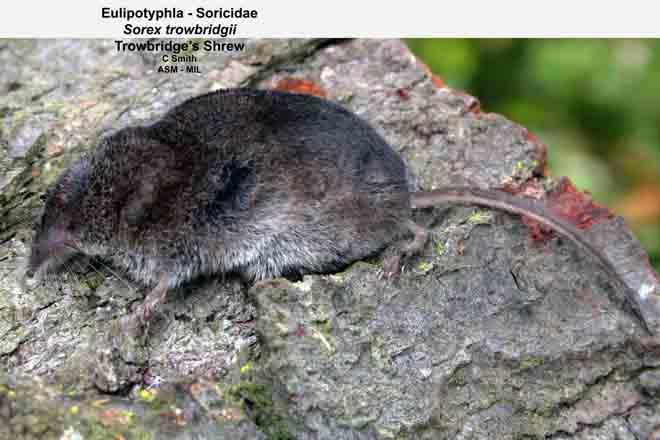Moderate
This subspecies of Trowbridge's shrew is endemic to Destruction Island. Its status and biology have not been assessed, but it may be threatened by introduced European rabbits who eat plants (“herbivory”) on the island, causing a decline in habitat quality.
Thirty specimens were collected in 1941 and six more were taken in 1983. The decline in trapping success between the two capture efforts suggests a possible population decline, but no further information on population status has been gathered since 1983.
Description and Range
Physical description
The Destruction Island shrew is small mammal with a long, hairy tail. Its fur is typically gray, with lighter shades on the belly. In summer, the fur can change to a dark brown. This shrew can weigh from 0.13 ounces to 0.18 ounces as an adult, and grow to about 4 to 5 inches long. Shrews are not rodents.
Ecology and life history
Shrews prefer deep rank grass near salmonberry patches, which can provide cover from predators. They primarily consume insects, but also feed on spiders, worms, and centipedes. These shrews are active year-round.
Geographic range
This shrew occurs only on Destruction Island in Jefferson County, Washington.
Climate vulnerability
Sensitivity to climate change
Moderate
Limited information is available regarding the biology and ecology of Destruction Island shrews and their potential response to climate change. This subspecies of Trowbridge’s shrew is endemic to Destruction Island; the small size of the island (12 hectares, 30 acres) makes the shrew’s population sensitive to any environmental changes. Extreme weather events (e.g., major storms) and/or unfavorable climatic periods (e.g., drought) are of concern and could negatively affect the island’s ecosystems. For example, possible climate-driven changes in prey availability (e.g., insects, spiders, worms, centipedes) and habitat suitability (e.g., vegetation cover) could impact these shrews.
Exposure to climate change
Low-
Moderate
- Increased extreme events
- Unfavorable climatic periods
Conservation
Conservation Threats and Actions Needed
- Resource information collection needs
- Threat: Status of life history have not been assessed.
- Action Needed: Current status and life history should be assessed.
- Invasive and other problematic species
- Threat: Herbivory by introduced European rabbits may be causing a decline in habitat quality.
- Action Needed: Eradication of European rabbits is needed on Destruction Island.
See the Climate vulnerability section above for information about the threats posed by climate change to this species.
Resources
References
Aubry, K. B., and S. D. West. 1984. The status of native and introduced mammals on Destruction Island, Washington. Murrelet 65:80-83.
Johnson, R. E., and K. M. Cassidy. 1997. Mammals of Washington state: location data and modeled distributions. Washington State GAP Analysis, Volume 3. Washington Cooperative Fish and Wildlife Research Unit, Seattle, Washington.
NatureServe. 2014. NatureServe Explorer: an online encyclopedia of life [web application]. Version 7.1. NatureServe, Arlington, Virginia. (accessed November 24, 2014).
